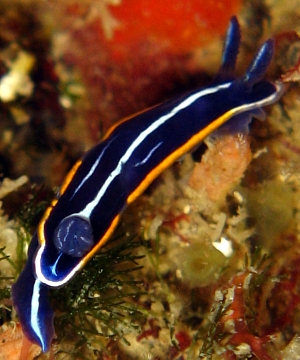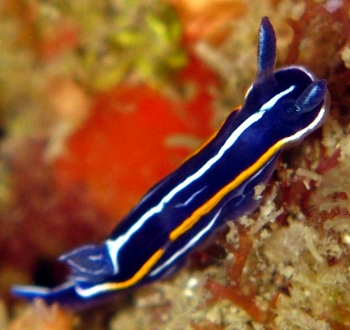Hypselodoris gasconi from Antibes ?
June 8, 2006
From: Dominique Horst

Hello Bill,
Again, I have a doubt about the following dorid. I initially thought it was Hypselodoris tricolor, but I noticed that the yellow line bordering the mantle is turning to white at the front and the back. I know (now) that color is not a feature determining a species, but having a look all around on the net, I've found pictures identified as Hypselodoris gasconi ... which fits pretty well.
I realized also that there is a recent message ot the Forum [#16566] which you replied to already. So it seems that this animal is traveling from Adriatic to the Mediterranean sea thisweek...
Locality: Cap d'Antibes, 20m, Antibes, France, Mediterranean sea, 05 June 2006, vertical rock. Length: 15mm. Photographer: Dominique Horst.
Best regards,
Dominique
dominique.horst@wanadoo.fr
Horst, D., 2006 (Jun 8) Hypselodoris gasconi from Antibes ?. [Message in] Sea Slug Forum. Australian Museum, Sydney. Available from http://www.seaslugforum.net/find/16807
Dear Dominique,
Thanks for these photos. The 'blue chromodorids' have been puzzling experts for 150 years. In the recent message you mention I express some doubts about how to distinguish H. gasconi from some of the colour forms of H. villafranca. Hopefully a local expert can help us. Both species are compared in the most recent revision of these animals but there seem to be few anatomical or colour differences between them.
All I can say is that your animals don't have a second white line near the mantle border, and so fit photographs of H. gasconi in the original description [Ortea et al, 1996: Fig 12A]. On that basis alone I have identified your animals as H. gasconi but I would appreciate some comments from local experts on how to distinguish the two species.
Concerning your comment that you now know 'that color is not a feature determining a species'. I hope I didn't mislead you in my earlier remarks. Colour is a good character in identification, but we need to know from other characters (such as anatomy) just what parts of the colour pattern are unique to a particular species. If we can do that, then the animal's colour pattern, or at least parts of it, become a valuable tool in accurate identification.
- Ortea, J., Valdes, A. & Garcia-Gomez, J.C. (1996) Review of the atlantic species of the Family Chromodorididae (Mollusca: Nudibranchia) of the blue chromatic group. Avicennia (Suppl. 1): 1-160
Best wishes,
Bill Rudman
